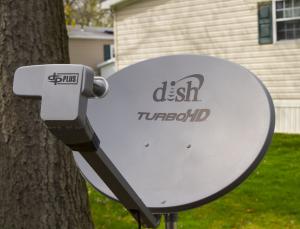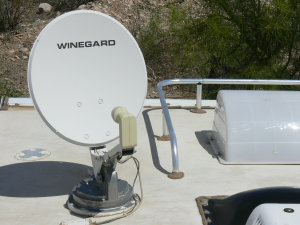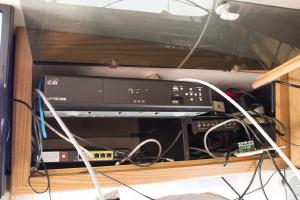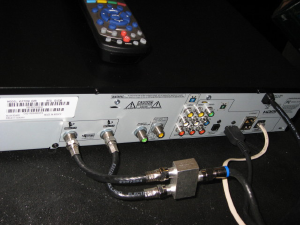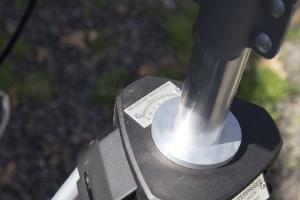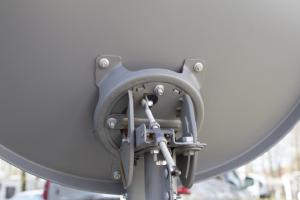–
For many people TV is a big part of life, and that is no different for us. We loves our TV and though I was originally a bit embarassed about that I’ve come to embrace it. When it comes to this subject, I thought I knew a lot but nothing gives you an education quite like an RV. When we bought our motorhome, a nice feature it had was a roof mounted automatic satellite. We quickly learned that the “automatic” feature didn’t work. We learned that through manual pointing and slow movements we were able to finally locate a satellite with it despite the fact that it was broken. That’s when the education started. I will note that when it comes to articles like this, it really makes me happy that our site is called “Geeky Nomads” and thus an expectation of tech talk is implied ;)
When Dish Network™ is installed at a house, a superdish or “turbo hd” dish or 1000.2 or if you’re ultra lucky a 1000.4 dish is installed. This dish is kind of a wide fat dish and one of the things I didn’t realize when we got our rv is that this roof top dish actually points to 3 satellites simultaneously. There are 3 little LNB eyes on the arm, and the satellite is bowed so that it reflects from different points in the sky to the different LNB’s. Pretty clever. The one on the roof of our RV can point to one satellite.
So to go back to basics here, Dish first came out with a satellite with a single LNB. The LNB is the little eye on the end of the arm that receives the signal. The most fundamental thing to understand is that unlike cable there is a lot more than you think happening on that coaxial cable coming out of the LNB. You cannot simply “split” the signal to attach more receivers and you most certainly can’t just hook the coax cable up to a tv. A radio signal is a wave and it has a concept of polarity. A nice benefit is that you can send two signals down the same frequency by make the polarities opposite of each other, allowing double the amount of data to be sent from a particular satellite. The original LNB could only use one polarity at a time which was commanded by your receiver. changing the voltage going to the LNB If two receivers were connected, they would fight over the polarity whenever both receivers wanted channels on different polarity. The solution to this was called a “dual LNB”. On a dual LNB there are two coaxial outputs. Two cables were run inside, one to one receiver and one to the other. Then each receiver could use whatever polarity they wanted and all was happy in the world. A dual LNB is not to be confused with a “twin LNB”. The twin LNB is actually TWO dual lnb’s side by side. a dual LNB only actually has one “eye” it’s just that it can operate in both polarities simultaneously. A twin LNB is used for seeing 2 satellites simultaneously.
So what does this mean to the geeky RVer? Well if you’re a normal geek you download your TV/movies from the internet from various services like Hulu or even RatBay if you’re so inclined. The problem is that on the road, bandwidth is really hard to come by. Park wifi is more or less shit while cell plans are limited to 20GB a month at best. At 300MB per hour of TV, you can suck up that limit very very quickly. Some research proves that coffee shop bandwidth is often limited to 1Mbit which is not great for downloading huge amounts of media from a server somewhere on the internet. The solution to this problem is to move from a downloaded setup to a DVR setup. In our case we got a Dish 722k DVR. In order to use a DVR you really need at least a dual LNB setup, and if you want to see all your channels you need a twin dual LNB (points at 2 satellites and polarity can be switched internally). This type of dish requires a skew setting and our roof top dish didn’t cut the mustard. Other roof top dishes say they support HD and it’s true but the trick to them is that they often don’t support multiple satellites simultaneously. When you tune the channel, the dish repoints. The issue with this is that if you are watching tv from one satellite and content to DVR is on another satellite - game over.
So we know our rooftop dish is inadequate and we’re shopping. We know most of the motorized dome type dish can only look at one or two satellites (often just one), have rain fade due to small dish size. Our automatic dish was also no longer automatic because it was locking onto satellites that it didn’t expect to be there. It didn’t realize that new satellites were put up because the new satellites never got programmed into the firmware confusing the hell out of it. The control panel was not able to sniff the signal to understand precisely what satellite it was seeing when it found a satellite and the guess was wrong. Only in the rare occasion that the offending satellites were obstructed did the automatic satellite finding system work. And speaking of obstructions 9 times out of 10 they were an issue with the roof top dish. Often the motorhome is positioned in the perfect place to block access to the satellites. Now there IS an automated rooftop dish that does meet our needs and that is the Wineagard Trav’ler Dish 1000. You can see the difference between this unit and the dome type, it’s huge and is not camouflaged in any way. It also cannot work “in-motion” and keep your tv going as you drive down the road. The price is over $1000. In light of the roof top obstructions we decided cons of a rooftop system could not outweight the positives and opted to remove our Dish satellite from the roof of our sticks and bricks home and get a tripod.
So to condense your research here is what I’ve learned. A modern DPP LNB has the switch BUILT IN to the LNB itself. This means that a DPP receiver over a single coax can see each LNB eye and control polarity independently, further with a DPP splitter, a single cable can handle TWO tuners (as in a DVR unit). When AIMING however, your satellite finder is NOT A DPP DEVICE. This means that if you hook it up to the first port you are seeing the signal of the first eye only. Thus your single cable should be on the middle of the 3 ports. THIS is the LNB you have to aim for in order to get all 3 satellites. The 3 satellites are for the eastern arc, 61.5, 72.7 and 77 and for western arc 110, 119, and 129. These numbers are the literal positions of the satellites in orbit. When you get coordinates for a 3 satellite system, the coordinate is for the middle satellite so aim using 72.7 or 119. Peak on that satellite and then fine tune your skew in order to peak the other two satellites (I don’t usually bother with this). There is a perfect dish for RVers and that is the Dish 1000.4. It is a slightly larger version of the fat boy 1000.2 dish. The LNB’s from different dishes are NOT interchangeable. Notice the proximity of 61.5, 72.7 and 77, The eastern arc. 77 and 72.7 are much closer in number than 61.5. This means that an eastern arc LNB is special. Two of the eyes are closer together and one is off to the side. The western arc LNB is evenly spaced because the satellites are spaced. It’s hard to hit eatern arc satellites when you are out west, and it is hard to hit western arc satellites when you are out east. Dish was going to migrate to 1000.4 only and so they produced an eastern arc AND western arc LNB for this dish, meaning you can buy both LNBs and you are SET. The 1000.2 only has a western arc LNB for it. Dish decided the 1000.4 was too expensive so they stopped producing western arc LNB’s for it and are going back to the 1000.2 setup for people out west. This means a 1000.4 western arc LNB is going toget rare, which is why I bought one on ebay now rather than have to pay more later. Another little known fact is that dish local channels are “spotbeamed”. This means that rather than a signal that can be received all across the country, the locals are generally sent in a tiny beam only to their intended local location. The result is that as soon as you start travelling out of your “home area” you lose your locals basically immediately. Dish is the only one I know of who has cracked this nut perfectly. The 722 receiver has a built in OTA module and the 722K has an optional $50 MTR2-OTA module that will allow you to pull in HD over the air local channels. The guide data for these channels is magically pulled down from the satellite and your DVR can record from these without using up satellite recording channels. And the DVR automagically updates ot hte new channels when you move. This means you can tell your DVR “I want to recover “The big bang theory”. That show may be broadcast on Fox 29 in one area, but once you move that channel is gone. The DVR schedule will find the new schedule on the other channel. This is a perfect solution, especially when you consider most RV’s come with an excellent amplified Winegard TV antenna.
Thus my final setup is a tripod, with a 1000.4 superdish connected to a DVR via the middle port on the LNB using a heavy duty TV4RV tripod. The DVR has the 2 satellite inputs split using a DPP splitter and thus can record one channel while watching another. The winegard tv antenna goes to the OTA input allowing a 3rd recording option for OTA channels so up to 3 watched/recorded channels simultaneously. Our recordings are about a 50⁄50 split between network and cable channels so it works perfectly. And that’s that. Simple and easy to understand. Not!
Last modified: 21 October, 2014
Created: 23 April, 2013

